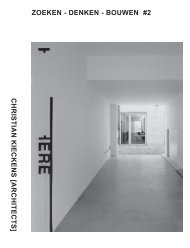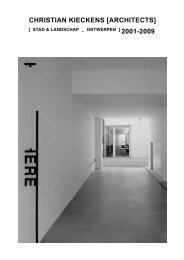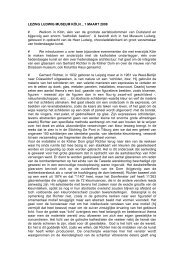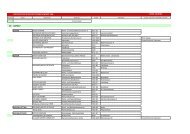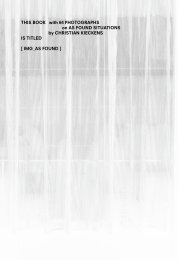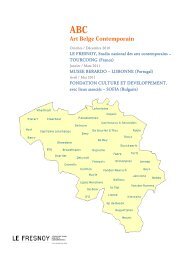download pdf - Christian Kieckens Architects
download pdf - Christian Kieckens Architects
download pdf - Christian Kieckens Architects
You also want an ePaper? Increase the reach of your titles
YUMPU automatically turns print PDFs into web optimized ePapers that Google loves.
Frazer MACDONALD HAY<br />
Gennaro POSTIGLIONE<br />
_ Worked for a variety of creative practices both in the UK and in The Netherlands<br />
while in the meanwhile working on a range of small and large scale projects, such<br />
as being part of the design team for the New Scottish Parliament Building.<br />
Researches through exhibitions, texts and colloquia on ‘Living Space’, ‘Interior<br />
Tools Interior Tactics’, ‘Thinking Inside the box’, ‘Tectonics-Making Meaning’,<br />
‘Systems to Recycle Buildings & The Interdisciplinary Nature of Interior<br />
Architecture’, ‘(Re)searching and Redefining the Content and Methods of<br />
Teaching Construction in the New Digital Era’, ‘Design and service industries’, ...<br />
Master in Conservation Architecture, ECA [Edinburgh College of Art].<br />
_ Gennaro Postiglione is Associate Professor in Interior Architecture at The<br />
Politecnico di Milano. Personal researches are focused on questioning relations<br />
between dwelling and built environment. He is also interested in Museography, in<br />
terms of preserving and diffusing collective memory and cultural identity.<br />
From 2005, he is promotor of PUBLIC ARCHITECTURE @ POLIMI, a research<br />
& operative group that puts the resources of Architecture in the service of the<br />
Public Interest. Identifying and proposing solutions for practical problems of human<br />
interaction with built environment, but also promoting a public discourse through the<br />
design of collective spaces and services [www.lablog.org.uk].<br />
Re-Use and Re-Cycle<br />
‘First we shape our buildings, then they shape us, then we shape them<br />
again-ad infinitum’ [Stewart Brand, 1994]<br />
How do we re-shape buildings? What are the benefits to re-using<br />
buildings? What are the architectural systems to re-use buildings?<br />
What is historically layered building fabric? Who re-shapes buildings<br />
beautifully? How do you extract the buildings DNA and then use it?<br />
How do you work with embodied energy? Is this a new architectural<br />
approach? How do you use the toolkit to re-cycle buildings?<br />
What is successful architectural intervention?<br />
Is architectural surgery the answer?<br />
Recycling and Re-using buildings is an essential way to breathe new life<br />
into our built environment. It’s an approach that acknowledges the building’s<br />
embodied energy and which depends on the designer’s analytical ability<br />
to manipulate the host building’s structural and contextual information<br />
successfully, which means Understanding its Architectural DNA.<br />
This workshop whilst answering will function as an Architectural surgery, a<br />
clinic for sick and disabled buildings. The signs, symptoms and DNA will be<br />
identified on a case by case basis and used to form a diagnosis. Treatment<br />
methods ranging from biomechanics, bionics, prosthetics, cardiology or<br />
even plastic surgery will be explored and tested.<br />
Urban Voids Exploitation:<br />
Profaning the Everyday Cityscape<br />
“To profane means returning to the free use of humankind, (...) and this access it is<br />
possible only through a profanation.” [G. Agambén].<br />
The profanation is the demolition of the precinct, the overcoming of the<br />
separation, the re-appropriation of spaces belonging to collective use and<br />
daily life. The profanation act happens through the direct use of places/<br />
spaces in order to allow the inhabitants to dwell each fragment and “hurt”<br />
open in the urban texture.<br />
The workshop aims at a multi-layers investigation of Antwerp urban<br />
voids, through their exploration and their correspondent representation,<br />
as the only possibility to generate sustainable & creative design<br />
proposals & solutions (exploitation) for public/collective space/service<br />
re-appropriations: the design programme will be defined through/by<br />
“discovered/revealed” solutions, with an inversion of standard design<br />
process. As Eraclìto suggests “if you don’t look for the unpredictable you<br />
will never find it”.<br />
12<br />
13



